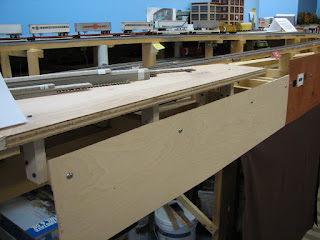
One comment from a recent posting asked me to elaborate a little on my layout's fascia. In general I use quarter-inch Birch plywood from Home Depot, sold in 2 x 4 foot sections. I hand pick through it to get non-warped good looking pieces. One side is usually better than the other. The smaller size of these pieces actually makes it easier to work with although I need more supports added to the benchwork. I cut the pieces to size to fit the area and attach them with stainless steel screws with mounting washers. These give a real nice look to to the layout and I take care to mount them evenly to help promote a professional look. After the pieces are installed I stain them with Minwax Cherry gel stain. I top that with a few coats of water-based Minwax polyurethane applied with a foam brush, lightly sanding between coats. Pictured to the right is a new piece added in Lyndonville, a section just getting started.
On the end of the peninsula I set the wood for mounting on a curve and bent the plywood around to match. I think it gives a nice complimentary look top the curve of the tracks.
In some areas I am using pieces of 3/4" pine and also poplar. I selected pieces without knots. Some of these were used because they were leftover from a previous layout and I did not need more than the 6 inch height they provide. In other areas I used it to build out shelves, as evidenced here in St. Johnsbury.
 I recall seeing something similar on another layout years ago and thought it would be a good idea to provide some flat surfaces to put things while building, working and also during operating sessions. It has been one of the most commented on features of the layout from other modelers. It was not too hard to build but does require a little forethought to provide adequate benchwork support and clearance. Basically the shelf rests on the 1 x 2 cross pieces direclty on the L-girder, while risers wee used to support the actual yard (plywood base).
I recall seeing something similar on another layout years ago and thought it would be a good idea to provide some flat surfaces to put things while building, working and also during operating sessions. It has been one of the most commented on features of the layout from other modelers. It was not too hard to build but does require a little forethought to provide adequate benchwork support and clearance. Basically the shelf rests on the 1 x 2 cross pieces direclty on the L-girder, while risers wee used to support the actual yard (plywood base). Under Morrisville, I did another long shelf like St. Johnsbury. In this picture you can see how the birch plywood simply butts up to the shelf section.
 It is all just built in place to fit and I add wood t the sides and behind the shelves to keep a good look to it. The shelves will be built in different areas mainly where switching activity will take place.
It is all just built in place to fit and I add wood t the sides and behind the shelves to keep a good look to it. The shelves will be built in different areas mainly where switching activity will take place.I have a not had any issues with the fascia and it cleans up real well if I spill some scenery material or glue on it. I know that this is a bit more effort than other styles of fascia (i.e. Masonite) but I like the look of wood and I think the Cherry color fits the theme of the layout, New England in the Fall.
As far as access, I have not built any doors or access panels in as of yet. Hidden track under the LVRC between Danville and Sheldon Jct. is basically accessed from underneath. But I may have to consider that a bit more as I get on to the areas with more hidden staging. The CV staging is probably OK because it is not close to the edge anyway. I may actually consider open areas below structures for some access. The Newport/Montreal staging is in place against the wall. If I build the fascia out far enough, i can ensure access from below and behind the fascia.
If there are any more questions, just add them in the comment section for this post.




